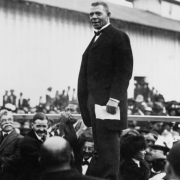As legend has it, the Statue of Liberty was a gift from the people of France to the American people as a gesture of friendship and admiration. Its sculptor, Frederic Auguste Bartholdi, designed it after the classical Roman goddess Libertas in order to proclaim the statue’s given name, “Liberty Enlightening the World.” However, Bartholdi originally wanted a commission from the Ottoman Viceroy to Egypt commemorating the completion of the Suez Canal. Its proposed title might have been “Egypt Enlightening the World” featuring a woman draped in a burqa overlooking a leading commerce center for the international slave trade from northern Africa to Asia.
As poetic justice would have it this idea was rejected as too expensive, and Bartholdi had a friend who was a poet, anti-slavery activist and devotee of American history. His name was Édouard René de Laboulaye and he had a much better idea. But it took an immigrant to America, a self-made man, to create the vision for the American people who were living the American dream of self-creation, and knew from whence their parents came. It took an entrepreneur to create the marketing plan that anticipated the desires of his customer base and finance the pedestal that put the Statue of Liberty in its rightful place – New York Harbor. That Poetic Justice Warrior is Joseph Pulitzer.
Crowd Funding for Liberty
While the neoclassical beauty of Lady Liberty and her pedestal is unquestioned, the network structure of its promoters and benefactors is also a thing of beauty. Other than the contribution of the land, the French and American governments contributed nothing to this work of fine art. All great ideas germinate in the mind of an individual, in this case it was René de Laboulaye’s – a fitting monument to America’s centennial and its abolition of slavery. Because of its scale, Liberty was going to need money, and the French American Union was formed. A French copper company donated the material and French gamblers raised most of the money for the sculpture by buying lottery tickets. Americans were solicited to raise money for the pedestal, the interior framework and the final assembly.
The engineering and financing challenges were daunting, and at first there was opposition to the project from wealthy New Yorkers and the New York Times who considered it a frivolous stunt, and potential donors from throughout the country who weren’t interested in financing something for the benefit of New York. By 1880 the copper sculpture’s funding was finalized in France, and in 1883 Pulitzer, who had just acquired the New York World newspapers, dedicated himself to an aggressive campaign to complete the remaining $100,000 of funding needed for the pedestal. He saw that America had created something unique in human history, the middle class, and over one hundred thousand donations, in very small amounts, were received in exchange for the notoriety of having their names printed in Pulitzer’s papers.
Pulitzer understood something that can only be appreciated in a country whose name is analogous to an idea – liberty – and whose ideology, the pursuit of happiness, has a corollary – to make money. America discovered that wealth must be earned, not looted, that money is a tool, and that money is the indispensable lubricant for free people creating and exchanging values. In this case, the value to Pulitzer’s donors was the concretization of one of their highest values – liberty, integrated in to a work of great art that lights the way to a future as it could and should be.
You Did Build That
Advocates for freedom will naturally gravitate to people and ideas that promote liberty and justice for all, and the Statue of Liberty project was no exception. Besides Pulitzer, de Laboulaye and the parents and school children in America and France who donated their nickels and dimes, there was a stellar team of engineers and builders who did the dangerous work and dirty jobs that they were free to do.
One such individual was Colonel Charles Stone. In 1884 he was named Chief Engineer for the Statue of Liberty project and planned the construction of the Liberty’s foundation, pedestal, and the reassembly of Liberty after its arrival from France. The pedestal was the largest concrete structure in the world at the time. Another was the highly accomplished civil engineer Joachim Giaever, a Norwegian immigrant who worked from sketches produced by Gustave Eiffel to create the structural framework and detailed fabrications needed to attach the copper shell to a structurally sound feat of engineering. This was the Gilded Age after all, the modern era when thousands of fortunes were built through the power of the human mind, not the brute force of the premodern era. The late 18th and 19th centuries featured the ethics of self-creation, the political economics of capitalism and the aesthetics of romanticism – all to be symbolized in New York Harbor.
It was the greatest period for human flourishing in history, and Joseph Pulitzer was ready for the challenges that freedom offers. Having arrived in America from Hungary at the age of 17, he migrated west in a box car after Civil War service where, he recalled, “The lights of St. Louis looked like a promised land to me.” Fluent in German, Hungarian and French he was able to quickly make connections in the affluent German immigrant community and spend his spare time in the St. Louis Mercantile Library learning English and reading voraciously. After stints as a cavalryman, whaler, mule hostler, waiter and lawyer Pulitzer found his life’s purpose as a journalist in 1868. The rest is history.
Reason, Purpose and Pride
By 1883, Pulitzer was a wealthy self-made man whose reputation was built on fighting political corruption and its crony corporatism. He was also a relentless self-promoter, as was Lady Liberty’s sculptor, and they both appealed to the sentiment of nationalist populism in France and America to raise the money needed to erect the statue atop the pedestal on Bedloe Island in New York Harbor. As poetic justice would have it, Pulitzer’s campaign provided the critical mass needed to trigger a chain reaction for inspiring lives of meaning world-wide.
The Statue of Liberty is a political monument to a higher principle – reason. It does not glorify a soldier or politician. While Liberty is the iconic welcome sign for the world, it is not about immigration, it is about ethics – living lives of purpose. And a compelling case can be made that it was not meant for the American people, but instead Lady Liberty’s colossal image was erected for the people of France. From New York Harbor she gazes east and encourages the people of France, and Europe, and the East to take pride in the fact that you can do this too – through value creating capitalism, as Poetic Justice Warrior Joseph Pulitzer did.













